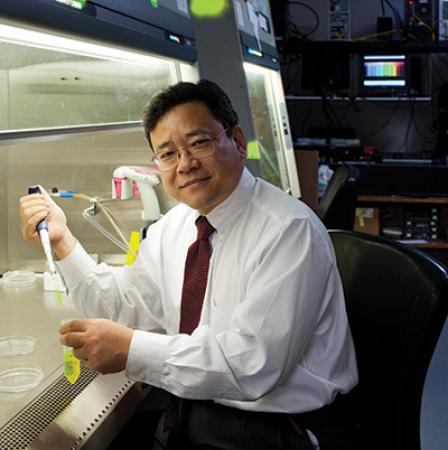Shuming Nie
This Atlanta professor uses tiny glow-in-the-dark particles to root out cancer
The only sure way to beat cancer is to remove it completely, with surgery. But the tumor margin—where cancerous cells merge into healthy tissue—is notoriously difficult to clear. Thanks to some Atlanta researchers, those gray areas are now a little less murky.
Shuming Nie, a biomedical engineering professor at Emory University and Georgia Tech and director of the Nanotechnology Center for Personalized and Predictive Oncology, is heading up a clinical trial for breast and pancreatic cancer, testing a new method of ensuring that every last tumor cell gets detected. Nie’s team injects patients with luminescent nanoparticles, which spread to the site of the tumor and bind with cancerous cells. When surgeons shine a specialized light on the area, tumor cells glow like stars in the night sky while healthy tissue remains dark. During one surgery for pancreatic cancer last year, this process revealed otherwise undetected malignant cells, which the doctors were then able to remove. “We believe we’ve already saved a few lives,” Nie says.
Nie’s background is in chemistry, but he found the dry academic output of that field unsatisfying. “I wanted to tackle big problems,” he says. Cancer was that big problem. Nie has focused on nanoscale engineering since coming to Atlanta from Indiana University in 2002. Here he joined an extensive community of nanomedicine researchers, including Georgia Tech professor Gang Bao, who leads two national centers. Nie’s team works at the state-of-the-art “clean room” lab at Marcus Nanotechnology Building on Tech’s campus.
Over the past decade, Nie has published almost 100 papers, filed twenty patents, and received too many awards to list. But for all his accomplishments, he is understated, working out of a small, neat office in the new Health Sciences Research Building on the east side of Emory’s campus.
“He’s definitely a relaxed person. He puts a lot of trust in the people who work with him and allows them the freedom to explore novel concepts or designs,” says Nie’s colleague Brad Kairdolf, an assistant professor and researcher. The team is also developing cancer-fighting drugs that could be sent straight to a tumor, though that technology is likely a decade away. Similar research could be used to fight cardiovascular disease, using nanoparticles to target plaque inside arteries.
In 2011 Atlanta-based Spectropath spun out of Nie’s research to commercialize the detection tool; it’s planned for an early 2015 launch in Europe, where the regulatory process takes less time. Spectropath CEO Ralph Gaskins, whose father died of colon cancer after an initial surgery failed to completely remove the tumor, became interested in the work after hearing a presentation by Nie in 2009. “My first thought was that this technology would have saved [my father’s] life,” says Gaskins.
Originally posted by Christine Van Dusen, Mary Jo DiLonardo, Van Jensen, and Carolyn Crist.
Media Contact
Keywords
Latest BME News
Jo honored for his impact on science and mentorship
The department rises to the top in biomedical engineering programs for undergraduate education.
Commercialization program in Coulter BME announces project teams who will receive support to get their research to market.
Courses in the Wallace H. Coulter Department of Biomedical Engineering are being reformatted to incorporate AI and machine learning so students are prepared for a data-driven biotech sector.
Influenced by her mother's journey in engineering, Sriya Surapaneni hopes to inspire other young women in the field.
Coulter BME Professor Earns Tenure, Eyes Future of Innovation in Health and Medicine
The grant will fund the development of cutting-edge technology that could detect colorectal cancer through a simple breath test
The surgical support device landed Coulter BME its 4th consecutive win for the College of Engineering competition.








